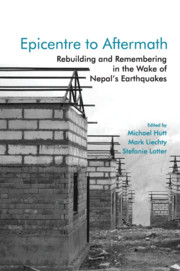2 - Earthquakes in Nepali History
Published online by Cambridge University Press: 08 July 2021
Summary
Introduction
The major earthquakes of 25 April and 12 May 2015 were the most recent in the long chain of such events to which the Himalayan region, at the junction of the South Asian and Eurasian tectonic plates, has been subject. For the inhabitants of the region, earthquakes are a significant part of historical memory, whether in the form of oral tradition or, as with the vamsavalis (chronicles) of the Kathmandu Valley, of written record. This chapter is intended to put the events of 2015 into historical context, looking in particular at the Nepal–Bihar earthquake of 1934 and the 1988 Nepal earthquake. The search for a historical perspective, whether formalized or not, follows naturally from human beings’ need to see themselves as part of a community existing over time. Specifically, in keeping with the theme of this volume, I will discuss the impact of these earthquakes on social, political, and cultural change.
Living with earthquakes in the pre-modern period
A list of major earthquakes in Nepal since 1100 is given as Appendix 2A. The first for which any details are recorded occurred on 7 June 1255, during the reign of King Abhayamalla:
The earthquake toppled very many houses and temples. It claimed the lives of one-third of the whole population, and the king himself died eight days later as a result. People left their houses and lived outside for a period of a fortnight to a month after the earthquake, while aftershocks were felt for the succeeding four months. (Pant 2002: 30)
The most destructive earthquake known from the historical record, rather than merely from geological evidence, was probably that of June 1505, which devastated much of Tibet, western Nepal, and Uttarakhand (D. Jackson 2002), and which may have killed one-third of the population of what is now Nepal (Himalayan Risk Research Institute n.d.). Such events must have had effects on political processes and on mentalities, but their detailed stories are not recoverable.
- Type
- Chapter
- Information
- Epicentre to AftermathRebuilding and Remembering in the Wake of Nepal's Earthquakes, pp. 22 - 46Publisher: Cambridge University PressPrint publication year: 2021
- 1
- Cited by



